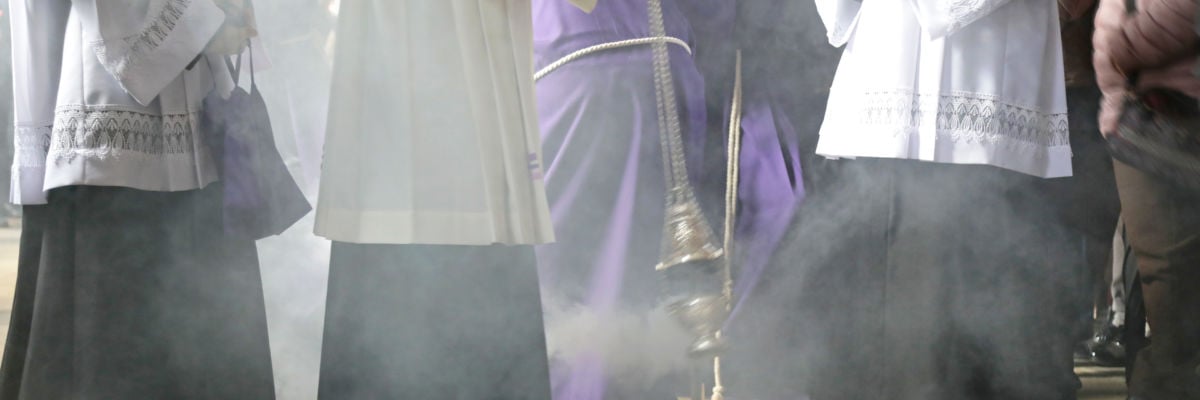
There are many ways to deepen our faith, and one way that continues to attract attention (and controversy) is the so-called traditional Latin Mass, the Roman Rite in use until around 1963. The TLM can be a challenge because it is not just one of several options for fulfilling one’s Sunday obligation; rather, it is a spirituality unto itself, an ecosystem all its own. And a new ecosystem can often make us feel lost in the woods.
One solution to this disorientation is a sort of “trad starter kit”— a collection of books for those who would like to learn more about the TLM. I do not believe that there is a definitive, one-size-fits-all list; much depends on the individual, his temperament, and his own background, and one man’s medicine can be another man’s poison. Some souls delight in the polemics of Michael Davies; others are offended by the tone. Some may be so gullible that they will listen to an argument only if a recent pope has made it; others may be so jaded that they will listen to an argument only if a recent pope has not made it. Some insist on scholarly rigor as the only way out of this mess; others despise scholars as the pinheads who got us into this mess in the first place. (On this point, at least, both points of view may be right). In any event, this diversity of readership needs to be taken into account when compiling a list. The best trad starter kit is tailor-made.
Starter kits are meant to help with those first steps on the path to perfection, and so we must identify what model of perfection we seek and then reverse-engineer. In my mind, a healthy and fruitful appropriation of our venerable Catholic patrimony has at least five marks, which I picture as concentric circles radiating outward. In order, they are
- to love the ancient Rite for the right reason,
- to pray the Mass,
- to know something about liturgical history,
- to know how to live out the liturgical year, and
- to have a healthy Catholic culture.
1. The Right Love for the Right Rite
As I explain elsewhere, you can love the right thing for the wrong reason. A trad starter kit should only contain materials that foster a healthy, positive love of sacred liturgy, a love that is based primarily not on a hatred of the new rite or of the current state of affairs in the Church or the world but on the intrinsics merits of the ancient rite itself. Moreover, it should not lose the forest for the trees. The only reason to love anything, be it sacred or profane, is that it draws one closer to the Love of our life, the person of Jesus Christ. If you rejoice in traditionalism because you can say with satisfaction, “Now I am on the right team,” think again. If you rejoice in the old rite because it makes you fall in love with the Sacred Heart and Holy Face of our Savior, you are on the right track.
Perhaps the best book on the market to strike this balance, practically speaking, is Joseph Shaw’s small introduction Small and Great: A Brief Introduction to the Traditional Latin Mass. One helpful feature of this book is that it addresses differences between the old and new iterations of the Roman Rite in a dispassionate manner. Lisa Bergman’s Treasure and Tradition: The Ultimate Guide to the Latin Mass is also even keeled and, with its meticulous formatting and stunning artwork, a visual feast for the eyes.
2. Pray the Mass
Pope St. Pius X taught us not to pray at Mass, but to pray the Mass. His admonition affirms the importance of liturgical literacy—that is, of being able to follow the ceremonies and prayers of the Mass and to have some grasp of their meaning. In liturgy as in relationships, knowledge and love are intertwined: My love of my beloved beckons me to know more about her, and my knowledge of her (especially if she’s a good egg) draws me into loving her more.
Happily, there is no dearth of literature promoting a prayerful and loving knowledge of the traditional Latin Mass and its parts. Classics from the past include Mother Mary Loyola’s Holy Mass: A Gift of Everlasting Sacrifice, Msgr. Ronald Knox’s witty The Mass in Slow Motion, and the ever-astute Maria Montessori’s The Mass Explained to Children. Msgr. George J. Moorman’s The Latin Mass Explained is more thorough and scholastic. Finally, one of the most recent contributions is also one of the best (at least for beginners in the postconciliar era): Abbé Claude Barthe’s A Forest of Symbols: The Traditional Mass and Its Meaning, trans. David J. Critchley (Angelico Press, 2023).
Finally, you should own your own hand Missal, for it allows you to meditate on the mysteries of the Mass both during and outside Mass. The experience of the Latin Mass should have an intoxicating effect on the soul, and you will want to know everything it has to say about the Trinity you love even outside Sunday worship. There is a plethora of good Missals available. Examples include Father F. X. Lasance’s The New Roman Missal (Omni Publications, 1993), Dom Gaspar Lefebvre’s Saint Andrew Daily Missal (St. Bonaventure Publications, 1999), Angelus Press’s The Roman Catholic Daily Missal (2004), and Baronius Press’s The Daily Missal and Liturgical Manual (2007). The importance of owning our own missal is especially obvious now, during Holy Week: Not all the ceremonies may be available in your area, but you will not want to miss meditating on the incredibly rich prayers, readings, and rituals of this great week.
3. History
In one respect, an accurate understanding of the last few hundred years of liturgical change is the least important goal on this list, for it does not contribute one whit to one’s holiness or salvation. Nonetheless, knowing our history can help with spiritual excellence insofar as it keeps us from falling into irrational extremisms—and moreover, ignorance of historical fact continues to impede genuine liturgical reform. For example, right now there are bishops—successors of the Apostles, mind you—who think that Vatican II mandated “Mass facing the people,” a patently false statement that can easily be refuted by a simple consultation of the text. Much misinformation abounds, even after certain myths have been exposed by sound scholarship.
With respect to good judgment about Church history, the key is to avoid the Scylla of conspiracy theory mania on one hand and the Charybdis of gaslighting papal or magisterial absolutism on the other. The goal is to have an emotionally and intellectually mature Catholic who can acknowledge that the Church can fail and has failed at the highest levels without ascribing sinister forces or evil intentions to every single snafu, and without losing faith in the Holy Spirit and the promises that Christ made regarding his Church. To conflate Charles Dickens and St. John Henry Newman, every chapter of Church history is the best of times and the worst of times. Get used to it.
One book that fulfills these criteria in a user-friendly manner is A Short History of the Roman Mass (Ignatius Press, 2024) by Fr. Uwe Michael Lang, an equanimous soul if there was one.
4. The Liturgical Year
When I first began attending the traditional Latin Mass in the mid-1990s, the traditionalists I knew were mainly focused on controversies regarding changes to the Ordinary of the Mass: the loss of the Prayers at the Foot of the Altar, of the Offertory prayers, of the Last Gospel, etc. Although such concerns are valid, they tended to overshadow another loss: that of a rich, nature-adjacent, and culturally fertile liturgical calendar. The calendar is important because it provides an annual rhythm for appropriating the overwhelming life-giving mysteries of our faith, both the mysteries of Christ in his life (the Temporal Cycle) and the mysteries of Christ in his saints (the Sanctoral Cycle). It is especially useful in adding meaning to our week.
The genius of the traditional Roman calendar became clear to me thanks to the writings of Francis X. Weiser, S.J., a polymath from the 1950s and ’60s (five doctoral degrees!) who also knew how to bring the hay down to the sheep in accessible prose. Weiser wrote several books on the calendar, but his magnum opus is A Handbook of Christian Feasts and Customs: The Year of the Lord in Liturgy and Folklore (1958). It is that combination of liturgy and folklore for which I am most grateful. Weiser examines the rites of apostolic liturgies around the world, but he also canvases the different folk customs that emanated willy-nilly from those liturgies. Because some of these customs are zany, illogical, and . . . uh, earthy, it makes for great reading—and great fodder for the family.
5. Catholic Culture (and Formation)
Speaking of the family, one of the reasons I remain a devoté of the older traditions is that they provide a nutritious spiritual diet for the domestic Church. Culture is an attempt to cultivate human excellence within a particular social context, but it is also rooted in cultus, the worship of God. Both meanings come into play with Catholic culture, which, while worshiping God and rendering to him his due, also shapes and forms individuals and peoples along the way. The liturgy’s impact on the individual is well articulated in Dietrich von Hildebrand’s Liturgy and the Personality. The liturgy’s impact on different cultures is surveyed in Weiser’s works and fleshed out in a growing number of more recent publications, such as Emily Stimpson Chapman’s Catholic Table, Carrie Gress’s Theology of Home, and above all, the wise matriarch Leila Lawler’s Summa Domestica. John Senior’s Restoration of Christian Culture, on the other hand, is a more aggressive take on what has been lost and what must be regained.
For intermediate readers, my wife Alexandra swears by Divine Intimacy by Fr. Gabriel of St. Mary Magdalen while I remain partial to the writings of Bl. Columba Marmion, OSB. His Words of Life: On the Margin of the Missal is excellent for sound-bite appropriations of the liturgical year, while his Christ in His Mysteries is excellent for those with a greater appetite for reading. And, of course, Dom Guéranger’s twelve-volume The Liturgical Year remains the gold standard, although it requires an aptitude for antiquated language.
But back to newbies and at the risk of delusional self-aggrandizement, I also think that my Drinking and Dining with the Saints series of books may be of value here, for their goal is to encourage not drunkenness or gluttony, but rather a merry Catholic culture in the midst of a bleak, postmodern world. There are two compliments about these books that I will always cherish. The first was when a parish priest in New Jersey, a state with its fair share of apostates, told me that Drinking with the Saints was one of the best evangelical tools he had in his arsenal. “For when I give a book on the saints to a fallen-away Catholic, a wall goes up,” he explained. “But when I give him a book on drinking, a wall goes down.” Second, a dad once told me that one night, he went around the table and asked each of his children what was their favorite book. When they got to the five-year-old, the boy replied, “Drinking with the Saints!” The youngster, mind you, was not mixing himself a martini every night; rather, his parents read the daily life of the saint before enjoying their evening libation, and he fell in love with the stories. It was building his culture even as his parents slaked their thirst.
God is good. Seek ye first his kingdom, and all else shall be added unto you.



